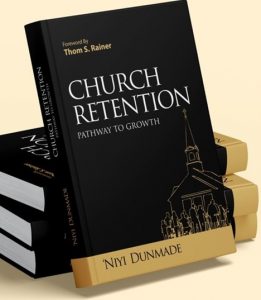The Dangers Of Low Church Retention Rates
By Certified Consultant, Niyi Dunmade
It is not news that many churches and denominations are experiencing decline in membership today and some are at the verge of closing their doors. Recently, I conducted a survey on approximately 600 church leaders in my country and the survey revealed that churches are experiencing a significant reduction in attendance.
 The outcome of my research spurred me to further studies leading to the release of my maiden book, Church Retention: Pathway To Growth. As a Church Leader, Minister or a Church Consultant, you cannot address many of the issues surrounding church growth without dealing with this all important issue of retention. A major reason many churches cannot retain members as deduced from my research was that local churches are weak in discipleship and evangelism.
The outcome of my research spurred me to further studies leading to the release of my maiden book, Church Retention: Pathway To Growth. As a Church Leader, Minister or a Church Consultant, you cannot address many of the issues surrounding church growth without dealing with this all important issue of retention. A major reason many churches cannot retain members as deduced from my research was that local churches are weak in discipleship and evangelism.
The fallout of this church decline is also traceable to continuous reduction in frequency of attendance, cultural Christianity and retention rates, leading to many of our churches being weak or unhealthy in areas where they ought to be strong or healthy. The early church should be today’s prescriptive model from which we can learn many lessons and draw wisdom on for continuous growth. The early church was strong in evangelism and discipleship and therefore experienced consistent growth and increase. We need to get back to these basics and foundational principles in order to experience the same level of growth for which the early church was known.
Another issue that comes to light is that some churches experience significant decline despite being in communities where the population is growing. A church cannot say it has achieved success with its’ growth rates declining over the years compared with the increasing growth rates of the communities. Having this case calls for great concern and attention.
Contrary to what many think, fewer people, from my findings, leave church because of differences on core doctrinal issues. Rather, many leave Churches because of soft or less significant issues. Some leave church because of gossip, cliques, interpersonal conflicts, lack of recognition as well as matters that have to do with their acceptance in a church.
A church cannot grow without people visiting. Often, persons who come to church for the first time hardly remember the message preached no matter how powerful. But most do remember how they were treated or how they felt from the healthy connections and interactions that occurred. They remember the environment of the church and how it fits with their status.
In the quest for church growth, it is very important that a church should have a proper management and process flow for converts and guests who come into the Church. Beyond paying attention to the front door, it is very important for churches to also focus on the back doors of the church to avoid losing old members, or new members shortly after they come into the fold of a church. A Church or its’ leaders may not have a second opportunity to create the preferred lasting impression on its’ newcomers, after the first impression. The more a church removes deal breakers, i.e. any factor or issue that is strong enough to determine a person’s membership commitment such as sense of belonging, adequate space, rest rooms, children’s facility, the better it is for the church. So, the church leadership must always put on its’ thinking cap to ensure any deal breakers are dealt with before such deals with the church eventually. The leadership must learn to see these issues holistically to be able to resolve them, as it has been found that some back doors problems are created right from the front door of the church.
There is a danger in not being able to retain those who visit a church for the first time. Where this goes on consistently for some time, there will be a devastating effect on the church. For example, if a church has a 20 percent retention rate, it means only 2 out of every 10 people that come into the church weekly are retained. The remaining 8 guests will go back into the community through the back door. Often, this can make the church lose its’ morale or momentum, miss out on opportunities or occurrences in the community and so on. It could also lead to other major issues that may be difficult to address.
Here Are Some Adverse Effects of a Low Retention Rates On A Local Church:
- A growing number of people familiar with the church leave through the back door but remain unconvinced to join the church or return to the church as second-time or third-time guests.
- A reduction in repeat and second time guests which affects church growth in the long run.
- Reduction in the number of referrals, especially within the community where the church is situated, thereby truncating the momentum of invitational culture.
- Erosion in the effect of church publicity and advertisements, especially as negative and lukewarm reviews will begin to counter whatever attraction strategies the church puts in place.
- An overall poor perception and brand image of the church. The more people refuse to remain in your church, the less trusting members of the public will be about your church.
A Church should aim to turn outsiders to guests, guests to believers, believers to disciples and then send out these disciples to repeat the cycle of making matured disciples.
In my book, Church Retention, I addressed the above issues in detail with other significant strategies that I believe a 21st century Church ought to consider and adopt to solve the problem of low retention and achieve church growth. These strategies include the concept of retention, 21st-century attraction & retention strategies, barriers to attractions etc. The book also addresses issues about care-giving, evangelism, discipleship, and assimilation processes to aid retention among several other issues.
The book is available online on Amazon.com:


